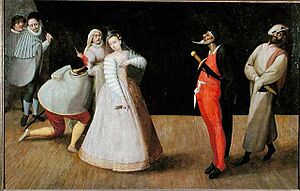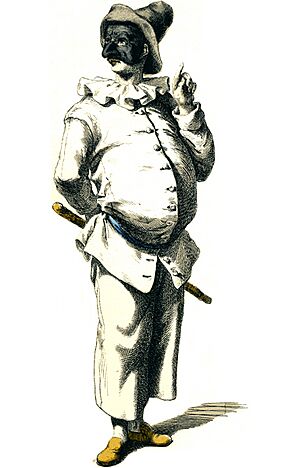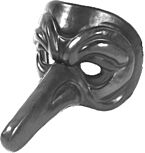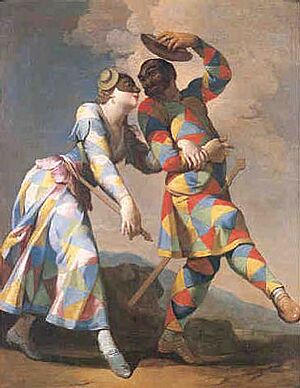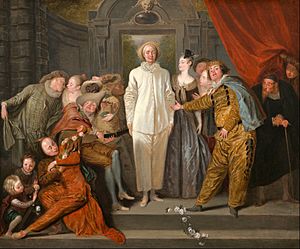Commedia dell'arte facts for kids
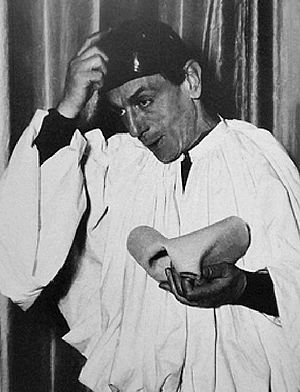
Commedia dell'arte (which means "comedy of the profession" in Italian) was a special kind of professional theatre that started in Italy. It was very popular all over Europe from the 1500s to the 1700s. It is also known as Italian comedy. This type of theatre is famous for its masked characters, who were like funny stereotypes that appeared in every play.
A key part of Commedia dell'arte was improvisation, where actors made up their lines and actions as they went along, based on a simple story outline. The plays were full of jokes, acrobatics, music, and dance. The actors used well-practiced physical jokes called lazzi. For example, a lazzo might be a character trying to catch a fly and causing chaos.
The characters were always the same types in every play. There were foolish old men like Pantalone, clever servants like Arlecchino (Harlequin), and young lovers called the innamorati. These characters traveled in acting groups, called troupes, and performed on temporary stages, often in town squares.
Contents
The Story of Commedia dell'arte
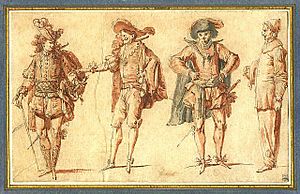
While some historians think the ideas for Commedia dell'arte might go all the way back to ancient Rome, the style we know today really got started in Italy in the 1500s. The first recorded performances were in Rome around 1551.
These plays were performed outdoors by professional actors who wore costumes and masks. This was different from another type of theatre at the time called commedia erudita ("learned comedy"), which was performed indoors by actors without masks.
By the mid-1500s, groups of actors, called troupes, started to form. One of the most famous troupes was called I Gelosi. They performed in northern Italy and France and were even supported by the King of France.
A very important change in theatre happened with Commedia dell'arte: women began acting on stage professionally. Actresses like Isabella Andreini became famous stars. This was new for Europe, and these women were some of the first professional actresses since ancient times.
In the 1600s, the plays became more structured. In France, the style became very popular and was known as the Comédie-Italienne. French playwrights like Molière were inspired by it and even shared a stage with Italian actors.
Later, in 1797, the French leader Napoleon outlawed Commedia dell'arte in Italy. He did not like that the actors could make up jokes on the spot, sometimes making fun of the government. Because of this, the tradition almost disappeared in Venice until it was brought back in 1979.
The Traveling Troupes
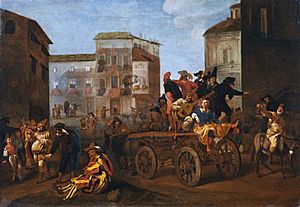
The actors in Commedia dell'arte worked in groups called compagnie, or companies. These were like traveling families of performers. Each actor in the troupe specialized in playing a certain type of character.
These troupes traveled all over Europe in big carts, carrying everything they needed, like costumes, props, and stage parts. They performed wherever they could find an audience, often at town fairs and festivals.
Sometimes, powerful nobles or kings would invite a troupe to perform for them. But the troupes usually did not stay in one place for too long. They wanted to keep their shows fresh and exciting for new audiences.
Famous Troupes
- Compagnia dei Fedeli
- Compagnia degli Accesi
- Compagnia degli Uniti
- Compagnia dei Confidenti
- I Dedosi
- I Gelosi
- Zan Ganassa
Meet the Famous Characters
The characters in Commedia dell'arte were "stock characters," meaning they were the same types of characters in every play. Each one had a special mask, costume, and way of talking and moving that made them instantly recognizable to the audience. The characters can be put into four main groups.
- Zanni: These were the servants and clowns. They were often silly and got into trouble. Famous Zanni include the acrobatic Arlecchino (Harlequin) and the clever Brighella.
- Vecchi: These were the "old men," who were usually rich and grumpy. The two most famous are Pantalone, a greedy merchant from Venice, and il Dottore, a know-it-all doctor from Bologna.
- Innamorati: These were the young lovers. They were fashionable, dramatic, and deeply in love with each other. Unlike most other characters, they did not wear masks. They had names like Flavio and Isabella.
- Il Capitano: The Captain was a bragging soldier who boasted about how brave he was, but was actually a coward. He often had a long, funny name and a big sword he was afraid to use.
The female characters, like the lovers and the clever maid Colombina, usually did not wear masks. This allowed the audience to see their facial expressions.
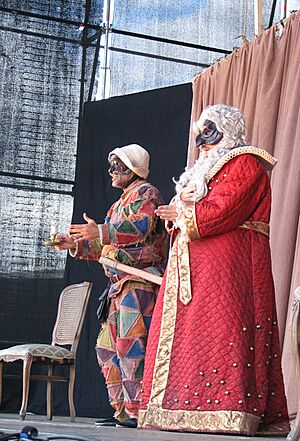
| Character | Mask? | Role | Costume |
|---|---|---|---|
| Brighella | Yes | A clever and tricky servant | White shirt and pants with green trim |
| Colombina | No | A smart and cheerful maid | Often wore a dress with patches, like Harlequin's |
| Harlequin | Yes | A funny and acrobatic servant | A suit with colorful diamond-shaped patches |
| Il Capitano | Yes | A bragging but cowardly soldier | A fancy military uniform |
| Il Dottore | Yes | A foolish, know-it-all professor or doctor | A black academic robe and hat |
| Innamorati | No | The young lovers | Dressed in the latest fashions of the time |
| Pantalone | Yes | A rich, greedy old man | A black cape and tight red pants |
| Pierrot | No (wore white face paint) | A sad and gentle clown | A baggy white costume with big buttons |
| Pulcinella | Yes | A grumpy servant with a hunched back | A baggy white outfit and a pointy hat |
| Scaramouche | Yes | A boastful adventurer | All-black costume |
Amazing Costumes and Masks
Each character had a special costume and mask that showed the audience exactly who they were. The masks usually covered only the top half of the face, so the actors could still speak clearly.
- Harlequin was famous for his costume made of colorful, diamond-shaped patches. He also carried a wooden sword or bat called a "slapstick," which was used to make a loud noise when hitting another actor. This is where the term "slapstick comedy" comes from.
- Il Dottore dressed like a scholar from the University of Bologna. He wore all black, including a long robe and a big hat.
- Pantalone wore a dark cape over a red jacket and tight red pants or stockings.
- Il Capitano wore a fancy military uniform to show off, but the style would change depending on where the play was set.
- The Innamorati (the lovers) wore the most fashionable clothes of the time and did not wear masks, but they did wear a lot of makeup.
What Were the Plays About?
The stories in Commedia dell'arte were often about love, jealousy, and funny mix-ups between the old and young characters. A typical plot would be:
The Innamorati (the young lovers) want to get married, but a vecchio (an old man), like Pantalone, forbids it. The lovers then ask the Zanni (the servants), like Harlequin or Colombina, for help. The servants come up with clever and silly plans to trick the old men and help the lovers get together. In the end, the story usually has a happy ending with a wedding.
Even though the actors had a basic plot to follow, they made up most of their lines and actions on the spot. This is called improvisation.
The actors also used well-practiced jokes and physical gags called lazzi. A lazzo could be a funny trick, a silly walk, or a short, repeated comedy routine. For example, a famous lazzo involved Harlequin trying to catch a fly and accidentally hitting his master instead.
Lasting Impact of Commedia dell'arte
Commedia dell'arte had a huge influence on theatre and art that is still seen today.
Influence on Theatre and Plays
Many famous playwrights were inspired by these Italian comedies. William Shakespeare used ideas from Commedia dell'arte for some of his characters. The French playwright Molière loved the style and used similar characters and plots in his own famous comedies.
The characters also inspired other forms of entertainment. The English puppet show Punch and Judy is based on the character of Pulcinella. The sad clown Pierrot and the clever Harlequin became famous characters in French pantomime and ballet.
Influence on Art and Music
Many artists loved to paint the colorful characters of the Commedia dell'arte. Famous painters like Jean-Antoine Watteau and Pablo Picasso created well-known paintings of the characters.
The stories and characters also appeared in music. The composer Igor Stravinsky wrote a ballet called Pulcinella. The characters also appear in many operas, where comic servants and foolish old men are common.
Even today, you can see the influence of Commedia dell'arte in clowns, circus acts, and even some cartoons and movies that use stock characters and physical comedy.
See also
 In Spanish: Comedia del arte para niños
In Spanish: Comedia del arte para niños
- Costumes in commedia dell'arte
- Theatre of Italy


